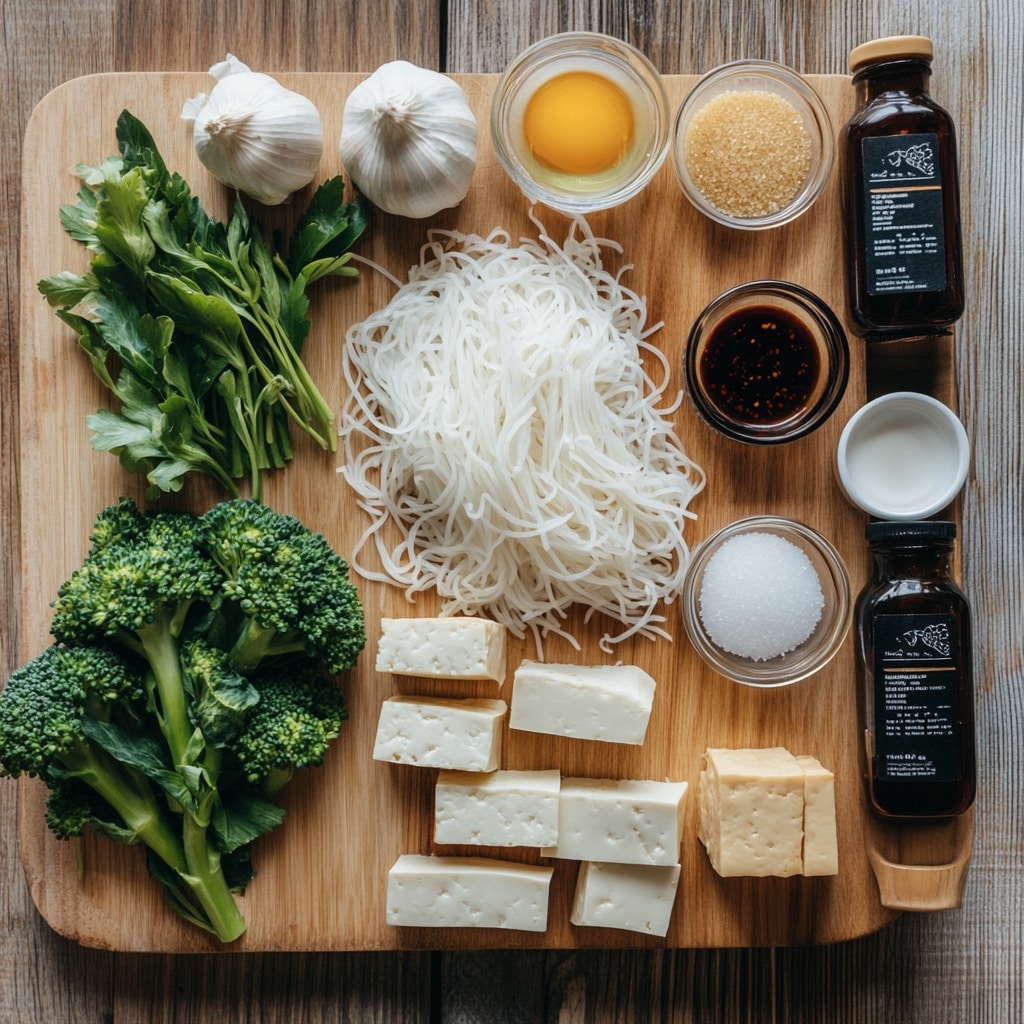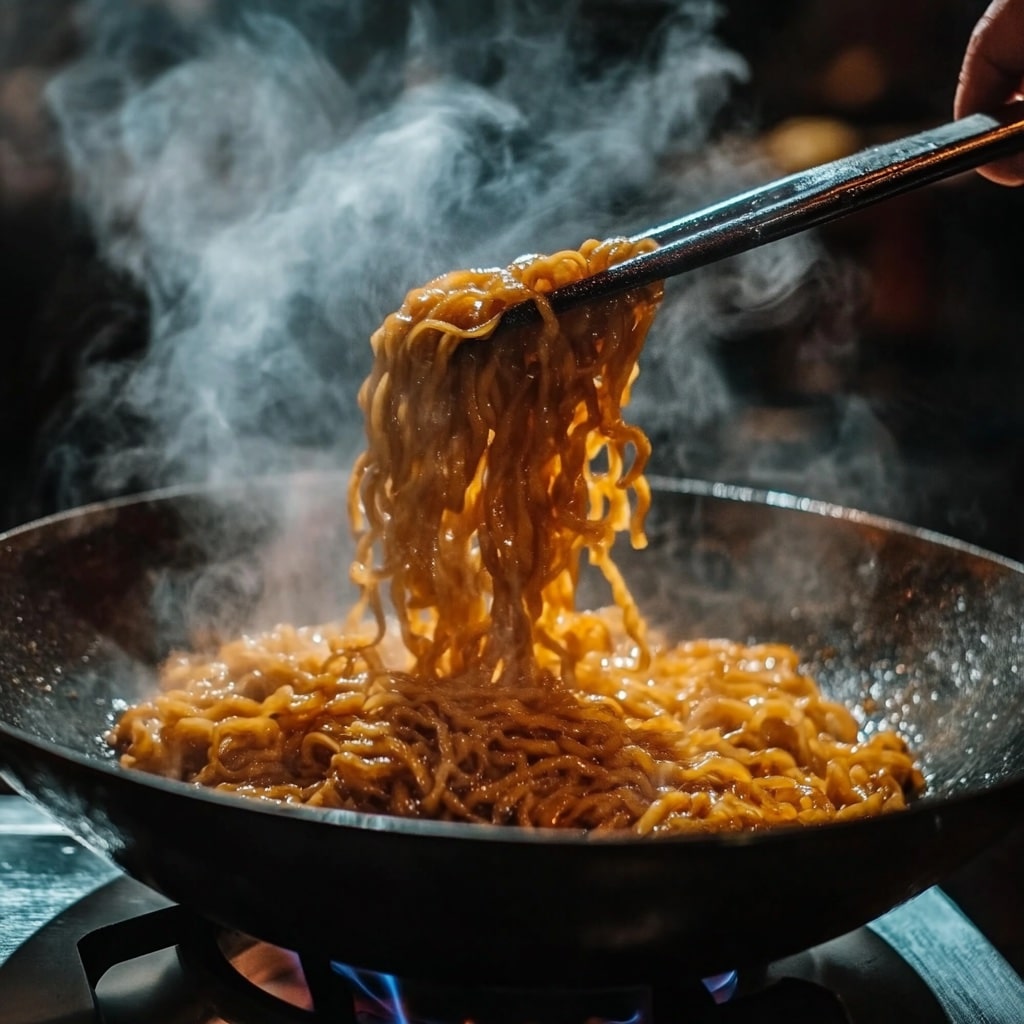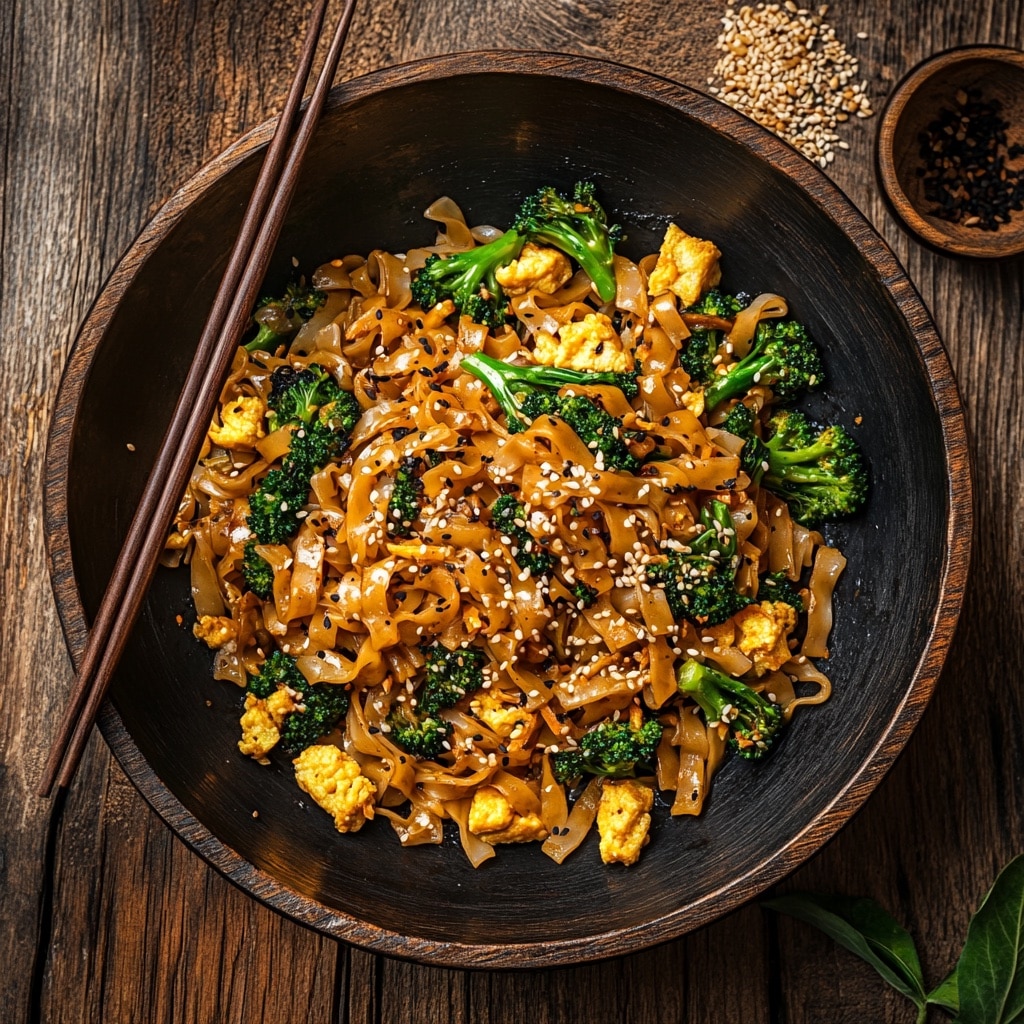From my first sizzling bite of phat si-io, I was hooked. The soy-slicked rice noodles reminded me of the Moroccan noodle dishes my mom would make, with smoky seared flavor from the wok, but with a Thai street-food soul. In our home, dinner wasn’t complete without a comforting bowl of something warm and hearty. Phat si-io hit all the right notes—sweet, savory, and just the right chew. It’s one of those meals that tastes like it took hours, but comes together in under 30 minutes.
In this article, I’ll walk you through everything you need to know to make delicious, foolproof phat si-io recipes at home. You’ll learn how to get the perfect wok-char, what ingredients make the flavor pop, which noodles work best, and easy variations that fit every diet and craving. Whether you’re new to Thai cooking or just hungry for a cozy noodle dish that never misses, you’re in the right kitchen.
We’ll also answer some fun questions like “What veggies go in pad see ew?” and “What makes Pad Thai orange?” Plus, I’ll link to a few recipes you’ll love, like my Mueller’s Mac and Cheese for the ultimate comfort side, or Amok Curry when you’re craving more Southeast Asian inspiration.
Table of Contents

Phat Si-Io Recipes: My Family’s Secret to Bold, Comforting Thai Noodles
- Total Time: 25 mins
- Yield: 2 servings 1x
Description
Classic Thai phat si-io recipes featuring wide rice noodles stir-fried with soy sauces, garlic, Chinese broccoli, and your choice of protein for a bold, smoky, and satisfying meal.
Ingredients
6 oz wide rice noodles, soaked if dried
2 tablespoons light soy sauce
1 tablespoon dark soy sauce
1 teaspoon sugar
1 tablespoon neutral oil (peanut or avocado)
2 cloves garlic, minced
1 egg
1 cup Chinese broccoli or bok choy, chopped
4 oz chicken, beef, or tofu
Optional: 1 teaspoon fish sauce, pinch of white pepper
Instructions
1. Soak rice noodles in warm water until soft, then drain.
2. Mix light soy, dark soy, sugar, and optional fish sauce in a small bowl.
3. Heat oil in a wok until smoking, add garlic, then protein. Cook through.
4. Add noodles and sauce mix, toss quickly to coat and char slightly.
5. Push noodles aside, crack egg in, scramble gently, then combine.
6. Add greens, stir-fry 1 more minute until wilted.
7. Serve hot with optional chili vinegar or white pepper.
Notes
Use tamari for gluten-free variation.
Tofu works best when pressed and seared first.
Always stir-fry in small batches to preserve wok heat.
- Prep Time: 10 mins
- Cook Time: 15 mins
- Category: Dinner
- Method: Stir-Fry
- Cuisine: Thai
Nutrition
- Serving Size: 1 bowl
- Calories: 420
- Sugar: 5g
- Sodium: 880mg
- Fat: 14g
- Saturated Fat: 3g
- Unsaturated Fat: 10g
- Trans Fat: 0g
- Carbohydrates: 58g
- Fiber: 4g
- Protein: 17g
- Cholesterol: 65mg
Why Phat Si-Io Recipes Are Your New Favorite Weeknight Go-To
A Noodle Dish Built on Balance and Boldness
Phat si-io (sometimes spelled pad see ew) is a Thai stir-fry classic built on wide rice noodles, soy sauces, garlic, and Chinese broccoli or similar greens. Unlike Pad Thai’s tangy brightness, phat si-io is deep, savory, and smoky, thanks to dark soy sauce and high-heat stir-frying. It’s incredibly popular in Thailand, and once you learn how fast and flexible it is, it might just become your weeknight hero.
This dish is a brilliant example of how Thai cooking balances salty, sweet, and umami. You’ll taste the bold flavor from soy sauces, a touch of sugar, and the subtle bitterness of greens like gai lan or broccoli. Add eggs for richness and protein like chicken, beef, or tofu—and you’ve got a well-rounded, one-pan meal.
To really nail that “wok hei” charred aroma, you’ll want to use a large wok or cast iron skillet. Keep your heat high and ingredients moving fast. This fast cooking method locks in flavor and gives those noodles the smoky depth that sets phat si-io apart.
From Thai Street Food to Lisa’s Family Table
I first discovered phat si-io when my cousin brought it over during a potluck. She had just gotten back from a Thailand trip and raved about it being “Thailand’s version of soy noodle comfort.” One bite, and I was hooked. It reminded me of my mom’s Moroccan tagines in the way it layered sweet and salty notes but with a total noodle twist.
I started making it with ingredients we already had at home—wide rice noodles, low-sodium soy sauce, dark soy, garlic, and eggs. Eventually, I added baby bok choy, because we always had it in the fridge. Now, it’s become one of the quick meals we rely on when dinner needs to happen fast, but still feel like something you want to sit down and savor.
Phat si-io is more than just a noodle dish—it’s part of my multicultural kitchen, where my dad’s love for simple American dinners and my mom’s North African roots meet in the middle. And the middle, in this case, is Thai noodles that hit every craving.
If you love cozy recipes like this, you’ll want to check out my Nun’s Puffs for a fun weekend treat or explore more in the Asian category where I share dishes with global inspiration.
Ingredients That Define Great Phat Si-Io Recipes
Choosing the Right Noodles and Sauces for Authentic Phat Si-Io Recipes
When it comes to delicious phat si-io recipes, success starts with the right noodles and sauces. The star of any phat si-io recipe is the wide rice noodles—the chewy, glossy kind that soaks up flavor without falling apart. Traditional phat si-io recipes use fresh sen yai noodles, but dried wide rice noodles work just as well if soaked until soft and flexible.
Your sauces matter just as much. The bold flavor of phat si-io recipes comes from a careful balance of:
- Light soy sauce for saltiness and depth
- Dark soy sauce for that signature color and molasses sweetness
- A bit of sugar to balance the salt
- Garlic, always fresh, always fragrant
- Optional fish sauce for that savory, funky layer
These ingredients define the flavor profile that makes phat si-io recipes stand out from other noodle dishes. Unlike stir-fries that just coat the noodles, phat si-io recipes build a caramelized glaze that clings to every bite.
Want to round out your meal with something indulgent? A dish like my Easy Milk Chocolate Mousse is perfect for dessert after mastering one of these savory phat si-io recipes.
Protein, Veggies, and Smart Swaps That Work in Phat Si-Io Recipes
One reason phat si-io recipes are so popular is their flexibility. They work with almost any protein:
- Chicken, thinly sliced
- Beef, lightly marinated
- Tofu, pressed and pan-seared
- Or just an egg, scrambled into the noodles
The vegetables in phat si-io recipes play a balancing role. The classic is Chinese broccoli (gai lan), which adds bitterness and crunch. But other greens can step in:
- Baby bok choy
- Kale or spinach
- Broccolini
- Even green beans, if you’re in a pinch
Wondering, “What veggies do you put in a pad see ew?”—another name for phat si-io recipes? Stick to crisp-tender greens that hold up to heat and don’t water down the dish.
If you’re exploring vegetarian-friendly phat si-io recipes, browse our vegetarian category for easy pairings and meatless ideas that still deliver on flavor.

Mastering the Stir-Fry Technique for Phat Si-Io Recipes
Get the Wok Hei Right in Your Phat Si-Io Recipes: High Heat, Fast Hands
If there’s one skill that takes phat si-io recipes from good to unforgettable, it’s mastering high-heat stir-frying. This technique is the heart of all great phat si-io recipes, giving you that irresistible smoky flavor known as wok hei. You don’t need a restaurant setup—just the right timing and heat.
For all your phat si-io recipes, follow these must-do steps:
- Use a wok or cast iron skillet
- Heat it until it smokes lightly before adding oil
- Cook ingredients in small batches to avoid steaming
Start with oil, then garlic. The moment it sizzles, you’re ready to build your phat si-io recipe. Add protein, cook through, then toss in the noodles and pour the sauce over them. Let them sit for 30 seconds to char, then stir to coat. That’s the flavor secret behind every standout phat si-io recipe.
The dark soy and sugar caramelize around the noodles. You’ll taste the difference instantly. This is where phat si-io recipes outshine typical soy noodle stir-fries—they don’t just taste good, they feel like a comforting, fast meal with layers of flavor.
Love this high-heat method? You’ll enjoy my Amok Curry too—different technique, same bold impact.

Timing Matters: How to Layer Ingredients in Phat Si-Io Recipes
Timing is everything in stir-frying, and that’s especially true for phat si-io recipes. Add ingredients in the right order to build texture and flavor:
- Garlic and aromatics first
- Protein next (chicken, beef, or tofu)
- Noodles and sauce go in together
- Finish with eggs and greens at the end
When making phat si-io recipes with egg, push the noodles to the side of the pan, crack in the egg, scramble slightly, then fold it in. It adds richness without turning everything mushy.
Wondering, “Are pad see ew and drunken noodles the same?” Not quite. While both use rice noodles, phat si-io recipes focus on soy sauce flavor with no spice, while drunken noodles are spicy and herbal with Thai basil and chili. They’re totally different dishes—even if they share a base.
Want a fun, unexpected side? Try these Nun’s Puffs for a playful way to finish your meal after a savory serving of phat si-io recipes.
Variations of Phat Si-Io Recipes for Every Diet and Taste
Vegetarian, Gluten-Free, and Kid-Friendly Phat Si-Io Recipes That Work
One reason people fall in love with phat si-io recipes is their flexibility. These recipes aren’t just delicious—they’re adaptable for almost every diet. Whether you’re feeding picky eaters or following a dietary plan, there’s a version of phat si-io recipes that works for you.
- Vegetarian phat si-io recipes are easy to build: just skip the fish sauce and meat, and use tofu or tempeh. For extra flavor, add a splash of lime juice with soy.
- Gluten-free phat si-io recipes swap out standard soy sauce for tamari or certified GF dark soy. Make sure your rice noodles are also gluten-free.
- Kid-friendly phat si-io recipes are a hit when you use mild flavors. Dial down the garlic, skip the fish sauce, and stick to tender greens like spinach with sliced chicken or scrambled egg.
These dietary versions still stay true to the heart of phat si-io recipes—bold, savory, and satisfying. For a nostalgic pairing that pleases all ages, serve them alongside my Mueller’s Mac and Cheese. Comfort meets comfort.
Customizing Phat Si-Io Recipes With Heat, Texture, and Bold Flavor
While classic phat si-io recipes are soy-rich and not spicy, you can easily turn up the heat. Customizing these noodles doesn’t take much, and it never sacrifices that signature flavor.
Here’s how to turn up the flavor in your favorite phat si-io recipes:
- Sprinkle in crushed red chili flakes or Thai chilis for heat
- Add a spoonful of chili vinegar or garlic-chili sauce on the side
- Finish with white pepper for a sharper, subtle spice
And if you’re wondering, “What makes Pad Thai so orange?”—that’s tamarind, paprika, or sometimes food coloring. Phat si-io recipes don’t rely on color; they rely on charred soy depth. That’s why their glossy brown sheen is part of what makes them visually and flavorfully distinct.
Looking to finish off your meal on a sweet note after one of these bold phat si-io recipes? My Easy Milk Chocolate Mousse is a no-fuss winner, just like this dish.
Step-by-Step Phat Si-Io Recipe You Can’t Mess Up
Ingredients You’ll Need (Serves 2)
Here’s a simple, pantry-friendly version of phat si-io that delivers restaurant-quality flavor at home.
- 6 oz wide rice noodles, fresh or soaked dried
- 2 tablespoons light soy sauce
- 1 tablespoon dark soy sauce
- 1 teaspoon sugar
- 1 tablespoon neutral oil (like peanut or avocado)
- 2 cloves garlic, minced
- 1 egg
- 1 cup Chinese broccoli or baby bok choy, chopped
- 4 oz chicken, beef, or tofu, thinly sliced
- Optional: 1 teaspoon fish sauce, pinch of white pepper
For a twist, pair this with something unexpected like my Nun’s Puffs—a surprising duo that brings both comfort and character to your table.
Cooking Instructions
- Prep your noodles: If using dried noodles, soak in warm water until pliable (not mushy), then drain.
- Mix sauces: Combine light soy, dark soy, sugar, and optional fish sauce in a small bowl.
- Cook protein: Heat oil in a hot wok or skillet. Add meat or tofu and cook until nearly done. Remove and set aside.
- Stir-fry garlic and greens: Add more oil if needed. Stir in garlic, then Chinese broccoli. Cook for 30 seconds until it wilts.
- Add noodles: Toss in your drained noodles and pour in the sauce mix. Stir quickly to coat and slightly char.
- Add egg: Push noodles to one side. Crack egg into the pan, scramble slightly, then fold it into the noodles.
- Combine and finish: Return the protein, toss everything together, and stir-fry 1 more minute to let flavors meld.
Serve immediately while hot and glossy. If you’re in the mood for more Southeast Asian inspiration, the Asian recipe category has tons of bold-flavored ideas to try next.
Conclusion: From Wok to Table, Phat Si-Io Is Pure Thai Comfort
Phat si-io isn’t just quick to make—it’s deeply comforting, flavor-packed, and endlessly flexible. It’s the kind of dish that welcomes whatever’s in your fridge and still delivers a meal that feels special. Whether you’re a beginner or noodle lover looking for something new, phat si-io recipes should be part of your weekly rotation.
From my multicultural kitchen to yours, I hope this dish brings your table as much joy as it brings mine. And if you’re craving more recipes that blend simplicity with bold taste, try something sweet like Easy Milk Chocolate Mousse or explore the dinner category for more EasyCooked favorites.
FAQ About Phat Si-Io Recipes
What are the 5 flavors of Pad Thai?
Pad Thai balances five key tastes: sweet (usually from palm sugar), sour (often from tamarind paste), salty (from fish sauce or soy), spicy (from chili), and umami (from dried shrimp or peanuts). Phat si-io, in contrast, focuses on salty and sweet, with a deep, savory soy base and no tamarind or shrimp.
Are pad see ew and drunken noodles the same?
No. Though both use wide rice noodles, pad see ew (phat si-io) is more mellow with sweet-salty soy flavors and minimal spice. Drunken noodles (pad kee mao) are fiery, herbal, and loaded with chili, garlic, and basil. Think of pad see ew as the calm cousin and pad kee mao as the bold one.
What veggies do you put in a pad see ew?
Traditional recipes use Chinese broccoli (gai lan), which has a bitter bite that balances the soy. But you can use baby bok choy, broccolini, or even kale if needed. Stick to hearty greens that won’t turn mushy in high heat.
What is the Chinese version of Pad Thai?
There isn’t a direct Chinese version of Pad Thai, but dishes like chow fun (wide rice noodles stir-fried with soy sauce and beef) share similarities. Chow mein is another close cousin—different flavors, but the same quick-fry, noodle-forward technique.
Is Phat Thai the same as Pad Thai?
Yes—Phat Thai is simply the more accurate Romanization of the Thai spelling. “Pad Thai” became more common in Western countries, but they refer to the same dish. Just note: phat si-io is a different noodle dish entirely, darker and more soy-forward than Pad Thai.
What makes Pad Thai so orange?
The bright orange color in some Pad Thai dishes comes from tamarind paste, paprika, and sometimes food coloring used by vendors. Phat si-io skips these, leaning into dark soy for a caramelized, brownish glaze.

